springboot实现定时任务,异步操作,统一结果返回,全局异常处理,拦截器及事务处理
定时任务
1.启动类开启注解
@EnableScheduling //开启基于注解的定时任务
@MapperScan("com.pdzx.dao")
@SpringBootApplication
public class VideoApplication {
public static void main(String[] args) {
SpringApplication.run(VideoApplication.class);
}
}
2.开启定时任务
@Component
public class ScheduledService {
//每2秒 执行任务
@Scheduled(cron = "0/2 * * * * ?")
public void hello(){
System.out.println("hello.....");
}
}
看结果
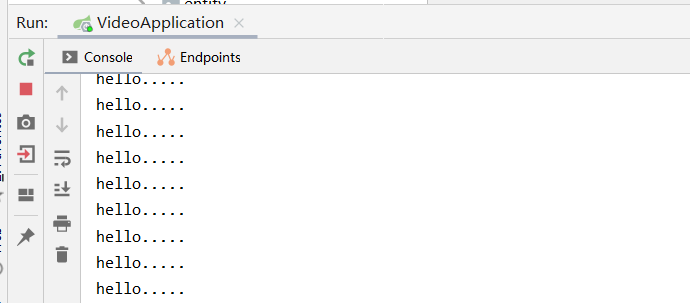
注意cron表达式的用法.
6个参数,分别为:秒 分 时 日 月 周
 通配符说明:
*:表示匹配该域的任意值。在minutes域使用 * 表示每分钟。在months里表示每个月。在daysOfWeek域表示一周的每一天。
?:只能用在daysofMonth和daysofWeek两个域,表示不指定值,当两个子表达式其中之一被指定了值以后,为了避免冲突,需要将另一个子表达式的值设为 ?。因为daysofMonth和daysofWeek会相互影响。例如想在每月的2号触发调度,不管2号是周几,则只能使用如下写法:0 0 0 2 * ?, 其中最后一位只能用?,而不能使用*,如果使用*表示不管周几都会触发。
-:表示范围。例如在minutes域使用5-20,表示从5分到20分钟每分钟触发一次
/:表示起始时间开始触发,然后每隔固定时间触发一次。例如在minutes域使用5/20,则意味着从当前小时的第5分钟开每20分钟触发一次。
,:表示列出枚举值。例如:在minutes域使用5,20,则意味着在5分和20分时各触发一次。
L:表示最后,是单词“last”的缩写,只能出现在daysofWeek和dayofMonth域。在daysofWeek域使用5L意思是在指定月的最后的一个星期四触发。在dayofMonth域使用5L或者FRIL意思是在指定月的倒数第5天触发。在使用L参数时,不要指定列表或范围。
W:表示有效工作日(周一到周五),只能出现在daysofMonth域,系统将在离指定日期的最近的有效工作日触发事件。例如:在daysofMonth使用5W,如果5号是周六,则将在最近的工作日周五,即4号触发。如果5号是周日,则在6日(周一)触发。如果5日在星期一到星期五中的一天,则就在5日触发。另外,W的最近寻找不会跨过月份 。
LW:这两个字符可以连用,表示指定月的最后一个工作日。
#:用于确定每个月第几个周几,只能出现在daysofMonth域。例如在4#2,表示某月的第二个周三。
通配符说明:
*:表示匹配该域的任意值。在minutes域使用 * 表示每分钟。在months里表示每个月。在daysOfWeek域表示一周的每一天。
?:只能用在daysofMonth和daysofWeek两个域,表示不指定值,当两个子表达式其中之一被指定了值以后,为了避免冲突,需要将另一个子表达式的值设为 ?。因为daysofMonth和daysofWeek会相互影响。例如想在每月的2号触发调度,不管2号是周几,则只能使用如下写法:0 0 0 2 * ?, 其中最后一位只能用?,而不能使用*,如果使用*表示不管周几都会触发。
-:表示范围。例如在minutes域使用5-20,表示从5分到20分钟每分钟触发一次
/:表示起始时间开始触发,然后每隔固定时间触发一次。例如在minutes域使用5/20,则意味着从当前小时的第5分钟开每20分钟触发一次。
,:表示列出枚举值。例如:在minutes域使用5,20,则意味着在5分和20分时各触发一次。
L:表示最后,是单词“last”的缩写,只能出现在daysofWeek和dayofMonth域。在daysofWeek域使用5L意思是在指定月的最后的一个星期四触发。在dayofMonth域使用5L或者FRIL意思是在指定月的倒数第5天触发。在使用L参数时,不要指定列表或范围。
W:表示有效工作日(周一到周五),只能出现在daysofMonth域,系统将在离指定日期的最近的有效工作日触发事件。例如:在daysofMonth使用5W,如果5号是周六,则将在最近的工作日周五,即4号触发。如果5号是周日,则在6日(周一)触发。如果5日在星期一到星期五中的一天,则就在5日触发。另外,W的最近寻找不会跨过月份 。
LW:这两个字符可以连用,表示指定月的最后一个工作日。
#:用于确定每个月第几个周几,只能出现在daysofMonth域。例如在4#2,表示某月的第二个周三。
常用表达式示例:
例如想在每月的2号触发调度,不管2号是周几,则只能使用如下写法:0 0 0 2 * ? , 其中最后一位只能用 ? ,而不能使用 * ,如果使用 * 表示不管周几都会触发
(1)0/2 * * * * ? 表示每2秒 执行任务 (1)0 0/2 * * * ? 表示每2分钟 执行任务 (1)0 0 2 1 * ? 表示在每月的1日的凌晨2点调整任务 (2)0 15 10 ? * MON-FRI 表示周一到周五每天上午10:15执行作业 (3)0 15 10 ? 6L 2002-2006 表示2002-2006年的每个月的最后一个星期五上午10:15执行作 (4)0 0 10,14,16 * * ? 每天上午10点,下午2点,4点 (5)0 0/30 9-17 * * ? 朝九晚五工作时间内每半小时 (6)0 0 12 ? * WED 表示每个星期三中午12点 (7)0 0 12 * * ? 每天中午12点触发 (8)0 15 10 ? * * 每天上午10:15触发 (9)0 15 10 * * ? 每天上午10:15触发 (10)0 15 10 * * ? 每天上午10:15触发 (11)0 15 10 * * ? 2005 2005年的每天上午10:15触发 (12)0 * 14 * * ? 在每天下午2点到下午2:59期间的每1分钟触发 (13)0 0/5 14 * * ? 在每天下午2点到下午2:55期间的每5分钟触发 (14)0 0/5 14,18 * * ? 在每天下午2点到2:55期间和下午6点到6:55期间的每5分钟触发 (15)0 0-5 14 * * ? 在每天下午2点到下午2:05期间的每1分钟触发 (16)0 10,44 14 ? 3 WED 每年三月的星期三的下午2:10和2:44触发 (17)0 15 10 ? * MON-FRI 周一至周五的上午10:15触发 (18)0 15 10 15 * ? 每月15日上午10:15触发 (19)0 15 10 L * ? 每月最后一日的上午10:15触发 (20)0 15 10 ? * 6L 每月的最后一个星期五上午10:15触发 (21)0 15 10 ? * 6L 2002-2005 2002年至2005年的每月的最后一个星期五上午10:15触发 (22)0 15 10 ? * 6#3 每月的第三个星期五上午10:15触发
异步操作
1.启动类开启注解
@EnableAsync //开启异步注解功能
@EnableScheduling //开启基于注解的定时任务
@MapperScan("com.pdzx.dao")
@SpringBootApplication
public class VideoApplication {
public static void main(String[] args) {
SpringApplication.run(VideoApplication.class);
}
}
2.注解标注异步方法
@Component
public class AsyncService {
//告诉Spring这是一个异步方法,SpringBoot就会自己开一个线程池,进行调用!
@Async
public void hello(){
try {
Thread.sleep(10000);
} catch (InterruptedException e) {
e.printStackTrace();
}
System.out.println("业务进行中....");
}
}
3.控制层测试
@RestController
public class AsyncController {
@Autowired
AsyncService asyncService;
@GetMapping("/async/hello")
public String hello(){
long time1 = System.currentTimeMillis();
asyncService.hello();//调用异步方法
long time2 = System.currentTimeMillis();
System.out.println("Controller :"+(time2-time1));
return "success";
}
}
访问该url,看结果
 异步生效了
异步生效了
统一结果返回
封装一个统一的返回类public class Result<T> {
//是否成功
private Boolean success;
//状态码
private Integer code;
//提示信息
private String msg;
//数据
private T data;
public Result() {
}
//自定义返回结果的构造方法
public Result(Boolean success,Integer code, String msg,T data) {
this.success = success;
this.code = code;
this.msg = msg;
this.data = data;
}
//自定义异常返回的结果
public static Result defineError(DefinitionException de){
Result result = new Result();
result.setSuccess(false);
result.setCode(de.getErrorCode());
result.setMsg(de.getErrorMsg());
result.setData(null);
return result;
}
//其他异常处理方法返回的结果
public static Result otherError(ErrorEnum errorEnum){
Result result = new Result();
result.setMsg(errorEnum.getErrorMsg());
result.setCode(errorEnum.getErrorCode());
result.setSuccess(false);
result.setData(null);
return result;
}
public Boolean getSuccess() {
return success;
}
public void setSuccess(Boolean success) {
this.success = success;
}
public Integer getCode() {
return code;
}
public void setCode(Integer code) {
this.code = code;
}
public String getMsg() {
return msg;
}
public void setMsg(String msg) {
this.msg = msg;
}
public T getData() {
return data;
}
public void setData(T data) {
this.data = data;
}
}
统一异常
public enum ErrorEnum {
// 数据操作错误定义
SUCCESS(200, "nice"),
NO_PERMISSION(403,"你没得权限"),
NO_AUTH(401,"你能不能先登录一下"),
NOT_FOUND(404, "未找到该资源!"),
INTERNAL_SERVER_ERROR(500, "服务器跑路了"),
;
/** 错误码 */
private Integer errorCode;
/** 错误信息 */
private String errorMsg;
ErrorEnum(Integer errorCode, String errorMsg) {
this.errorCode = errorCode;
this.errorMsg = errorMsg;
}
public Integer getErrorCode() {
return errorCode;
}
public String getErrorMsg() {
return errorMsg;
}
}
全局异常处理
Springboot对于异常的处理也做了不错的支持, 它提供了一个 @ControllerAdvice注解以及 @ExceptionHandler注解,前者是用来开启全局的异常捕获,后者则是说明捕获哪些异常,对那些异常进行处理。如下 1.自定义异常public class DefinitionException extends RuntimeException {
protected Integer errorCode;
protected String errorMsg;
public DefinitionException(){
}
public DefinitionException(Integer errorCode, String errorMsg) {
this.errorCode = errorCode;
this.errorMsg = errorMsg;
}
public Integer getErrorCode() {
return errorCode;
}
public void setErrorCode(Integer errorCode) {
this.errorCode = errorCode;
}
public String getErrorMsg() {
return errorMsg;
}
public void setErrorMsg(String errorMsg) {
this.errorMsg = errorMsg;
}
}
2.全局异常处理
@ControllerAdvice
public class GlobalExceptionHandler {
/**
* 处理自定义异常
*/
@ExceptionHandler(value = DefinitionException.class)
@ResponseBody
public Result bizExceptionHandler(DefinitionException e) {
return Result.defineError(e);
}
/**
* 处理其他异常
*/
@ExceptionHandler(value = Exception.class)
@ResponseBody
public Result exceptionHandler( Exception e) {
return Result.otherError(ErrorEnum.INTERNAL_SERVER_ERROR);
}
}
测试
@RequestMapping("/getDeException")
public Result DeException(){
throw new DefinitionException(400,"我出错了");
}
@RequestMapping("/getException")
public Result Exception(){
Result result = new Result();
int a=1/0;
return result;
}
看结果
首先看自定义异常
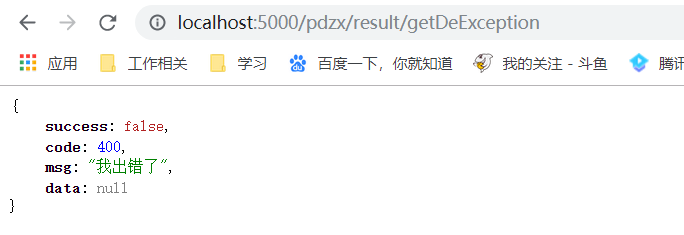 看其他异常结果
看其他异常结果

拦截器
拦截器是在servlet执行之前执行的程序(这里就是controller代码执行之前),它主要是用于拦截用户请求并作相应的处理,比如说可以判断用户是否登录,做相关的日志记录,也可以做权限管理。 SpringBoot中的拦截器实现和spring mvc 中是一样的, 它的大致流程是,先自己定义一个拦截器类,并将这个类实现一个 HandlerInterceptor 类,或者是继承 HandlerInterceptorAdapter ,都可以实现拦截器的定义。 然后将自己定义的拦截器注入到适配器中,也有两种方式,一种是实现 WebMvcConfigurer 接口,一种是继承 WebMvcConfigurerAdapter 。下面我们来看看如何完成。1.自定义拦截器
/**
*
* 自定义的拦截器可以实现HandlerInterceptor接口,也可以继承HandlerInterceptorAdapter类。
重写三个方法,当然也可以只实现一个最重要的preHandle方法。
preHandle方法:此方法会在进入controller之前执行,返回Boolean值决定是否执行后续操作。
postHandle方法:此方法将在controller执行之后执行,但是视图还没有解析,可向ModelAndView中添加数据(前后端不分离的)。
afterCompletion方法:该方法会在整个请求结束(请求结束,但是并未返回结果给客户端)之后执行, 可获取响应数据及异常信息。
*/
public class MyInterceptor implements HandlerInterceptor {
@Override
public boolean preHandle(HttpServletRequest request, HttpServletResponse response, Object handler) {
System.out.println("进入拦截器了");
//中间写逻辑代码,比如判断是否登录成功,失败则返回false
return true;
}
@Override
public void postHandle(HttpServletRequest request, HttpServletResponse response, Object handler, ModelAndView modelAndView) {
//
System.out.println("controller 执行完了");
}
@Override
public void afterCompletion(HttpServletRequest request, HttpServletResponse response, Object handler, Exception ex) {
System.out.println("我获取到了一个返回的结果:"+response);
System.out.println("请求结束了");
}
}
2.拦截器注入适配器
@Configuration
public class InterceptorConfig implements WebMvcConfigurer {
@Override
public void addInterceptors(InterceptorRegistry registry) {
registry.addInterceptor(new MyInterceptor())
.addPathPatterns("/**")//拦截所有的路径
.excludePathPatterns("/LoginController/*")//配置不需要拦截的路径。
.excludePathPatterns("/hello/login");//配置多个路径。
}
}
3.先创建一个登陆的测试,这个接口是不会拦截的。
@RestController
@RequestMapping("LoginController")
public class Login {
@RequestMapping("/login")
public String login(){
System.out.println("controller开始执行");
return "login success";
}
}
浏览器测试
http://localhost:5000/pdzx/LoginController/login看结果
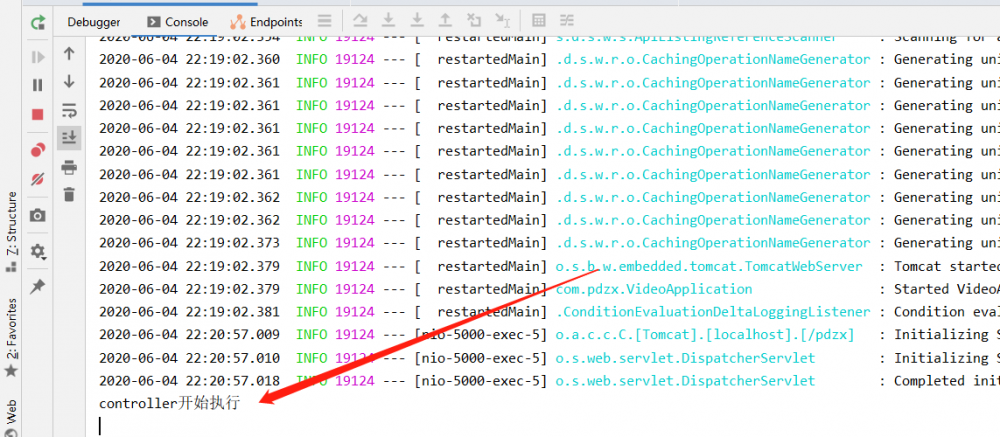 控制台只输出了未拦截接口内的代码,说明这个接口是未拦截的。浏览器的显示就不管了。其实一般是拦截登录接口,这里就将它放开了,以供测试。
控制台只输出了未拦截接口内的代码,说明这个接口是未拦截的。浏览器的显示就不管了。其实一般是拦截登录接口,这里就将它放开了,以供测试。
4..创建一个拦截的controller
@RestController
@RequestMapping("/hello")
public class HelloController {
@RequestMapping("/hello")
public String hello(){
System.out.println("经过拦截的controller代码执行完毕");
return "hello";
}
@RequestMapping("/login")
public String login(){
System.out.println("不拦截的controller代码执行完毕");
return "hello login";
}
}
测试
http://localhost:5000/pdzx/hello/hello看结果
 可以看到,首先是进入了拦截器,
通过拦截器之后,进入了controller中的方法,执行完controller的代码之后就进入了自定义拦截器中的postHandle方法,最后进入afterCompletion方法,并获取到了一个response对象。
可以看到,首先是进入了拦截器,
通过拦截器之后,进入了controller中的方法,执行完controller的代码之后就进入了自定义拦截器中的postHandle方法,最后进入afterCompletion方法,并获取到了一个response对象。
事务处理
1.开启事务支持@EnableTransactionManagement//开启事务支持
@EnableAsync //开启异步注解功能
@EnableScheduling //开启基于注解的定时任务
@MapperScan("com.pdzx.dao")
@SpringBootApplication
public class VideoApplication {
public static void main(String[] args) {
SpringApplication.run(VideoApplication.class);
}
}
2.@Transactional来修饰一个方法
@Service
public class UserInfoServiceImpl {
@Autowired
private UserInfoMapper userInfoMapper;
public int insertSelective(UserInfo record) {
return userInfoMapper.insertSelective(record);
}
public int updateByPrimaryKeySelective(UserInfo record) {
return userInfoMapper.updateByPrimaryKeySelective(record);
}
@Transactional
public void add1(UserInfo record){
userInfoMapper.insertSelective(record);
int i=1/0;
}
}
3.controller
@RequestMapping("userInfo")
@RestController
public class UserInfoController {
@Autowired
private UserInfoServiceImpl userInfoService;
@RequestMapping("/add1")
public void add1(){
UserInfo userInfo=new UserInfo();
userInfo.setName("张三");
userInfoService.add1(userInfo);
}
}
请求该路径之前,看一下数据库
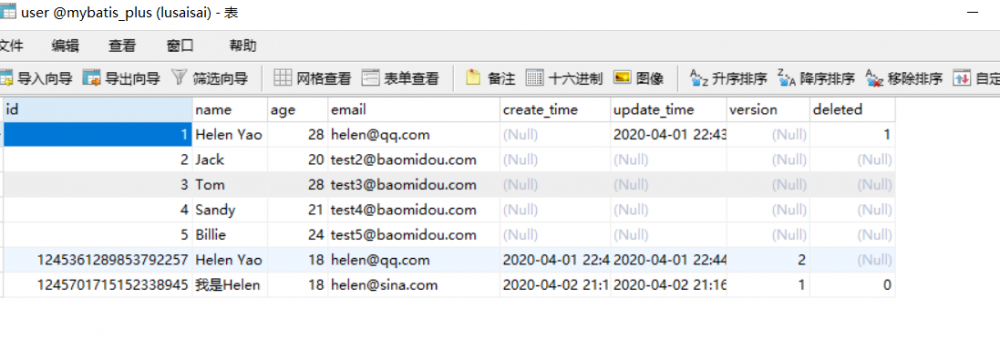 请求该接口
请求该接口
http://localhost:5000/pdzx/userInfo/add1看结果
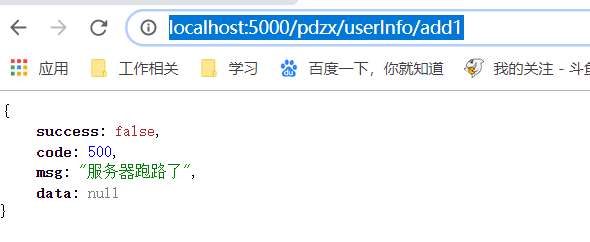 看控制台和数据库
看控制台和数据库

 数据没进入数据库
我们把那行错误注释掉
数据没进入数据库
我们把那行错误注释掉
@Transactional
public void add1(UserInfo record){
userInfoMapper.insertSelective(record);
//int i=1/0;
}
再试一下,看结果
 结果了,可以看出,事务处理生效了.
我们再看一个情况:
不带事务的方法调用该类中带事务的方法,不会回滚。
因为spring的回滚是用过代理模式生成的,如果是一个不带事务的方法调用该类的带事务的方法,直接通过
结果了,可以看出,事务处理生效了.
我们再看一个情况:
不带事务的方法调用该类中带事务的方法,不会回滚。
因为spring的回滚是用过代理模式生成的,如果是一个不带事务的方法调用该类的带事务的方法,直接通过 this.xxx() 调用,而不生成代理事务,所以事务不起作用
看代码,add2,调用带事务处理的updateByPrimaryKeySelective
@Transactional
public int updateByPrimaryKeySelective(UserInfo userInfo) {
int i=1/0;
userInfo=new UserInfo();
userInfo.setId((long)100);
userInfo.setName("李四");
return userInfoMapper.updateByPrimaryKeySelective(userInfo);
}
public void add2(UserInfo record){
userInfoMapper.insertSelective(record);
updateByPrimaryKeySelective(record);
}
controller层
@RequestMapping("/add2")
public void add2(){
UserInfo userInfo=new UserInfo();
userInfo.setId((long) 150);
userInfo.setName("张三");
userInfoService.add2(userInfo);
}
测试
http://localhost:5000/pdzx/userInfo/add2看控制台和数据库

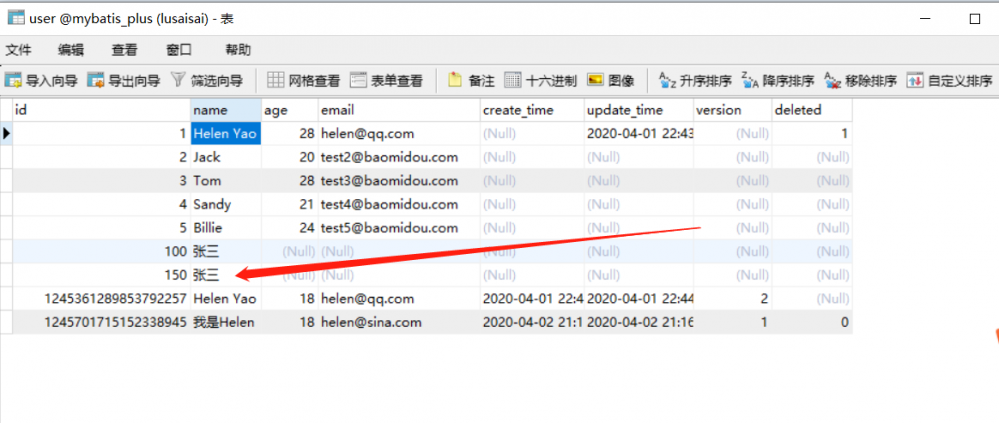 可以看到数据存到数据库了,事物没有生效,这个情况还需注意
可以看到数据存到数据库了,事物没有生效,这个情况还需注意
正文到此结束
热门推荐
相关文章
Loading...











![[HBLOG]公众号](https://www.liuhaihua.cn/img/qrcode_gzh.jpg)

